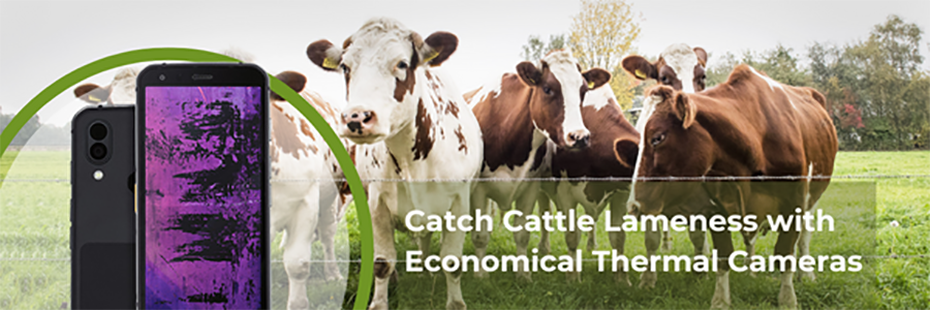 FarmingUK reports that lameness affects between 20% and 25% of cattle across the UK. Usually treated with expensive antibiotics, lameness costs the dairy industry approximately £53 million a year.[1] It has long been acknowledged that thermal imaging can provide an effective method of detecting lameness. Infections or inflammations are often the root cause of lameness and both conditions emit heat which can be picked up by a thermal imager. Catching lameness early and identifying its source means farmers can target their treatments more effectively. For example, lameness caused by an infection can be treated earlier with a shorter course of antibiotics, saving money; whereas lameness resulting from inflammation may be treated more effectively and economically with anti-inflammatories; by blocking the affected claw; or by keeping the cow on a soft surface until she has recovered. Until recently, farmers have been reluctant to invest in thermal imaging as it was thought that only high-end, very expensive models were sophisticated enough to reveal lameness. However, a recent study by Aidan Coe of the Royal Veterinary College (RVC) has discovered that less costly thermal imaging models are just as suitable for recognising lameness in cattle, potentially offering farmers significant savings while also improving the welfare of cows.
Continue reading →
FarmingUK reports that lameness affects between 20% and 25% of cattle across the UK. Usually treated with expensive antibiotics, lameness costs the dairy industry approximately £53 million a year.[1] It has long been acknowledged that thermal imaging can provide an effective method of detecting lameness. Infections or inflammations are often the root cause of lameness and both conditions emit heat which can be picked up by a thermal imager. Catching lameness early and identifying its source means farmers can target their treatments more effectively. For example, lameness caused by an infection can be treated earlier with a shorter course of antibiotics, saving money; whereas lameness resulting from inflammation may be treated more effectively and economically with anti-inflammatories; by blocking the affected claw; or by keeping the cow on a soft surface until she has recovered. Until recently, farmers have been reluctant to invest in thermal imaging as it was thought that only high-end, very expensive models were sophisticated enough to reveal lameness. However, a recent study by Aidan Coe of the Royal Veterinary College (RVC) has discovered that less costly thermal imaging models are just as suitable for recognising lameness in cattle, potentially offering farmers significant savings while also improving the welfare of cows.
Continue reading →Dairy Farming
-
Catch Cattle Lameness with Economical Thermal Cameras
 FarmingUK reports that lameness affects between 20% and 25% of cattle across the UK. Usually treated with expensive antibiotics, lameness costs the dairy industry approximately £53 million a year.[1] It has long been acknowledged that thermal imaging can provide an effective method of detecting lameness. Infections or inflammations are often the root cause of lameness and both conditions emit heat which can be picked up by a thermal imager. Catching lameness early and identifying its source means farmers can target their treatments more effectively. For example, lameness caused by an infection can be treated earlier with a shorter course of antibiotics, saving money; whereas lameness resulting from inflammation may be treated more effectively and economically with anti-inflammatories; by blocking the affected claw; or by keeping the cow on a soft surface until she has recovered. Until recently, farmers have been reluctant to invest in thermal imaging as it was thought that only high-end, very expensive models were sophisticated enough to reveal lameness. However, a recent study by Aidan Coe of the Royal Veterinary College (RVC) has discovered that less costly thermal imaging models are just as suitable for recognising lameness in cattle, potentially offering farmers significant savings while also improving the welfare of cows.
Continue reading →
FarmingUK reports that lameness affects between 20% and 25% of cattle across the UK. Usually treated with expensive antibiotics, lameness costs the dairy industry approximately £53 million a year.[1] It has long been acknowledged that thermal imaging can provide an effective method of detecting lameness. Infections or inflammations are often the root cause of lameness and both conditions emit heat which can be picked up by a thermal imager. Catching lameness early and identifying its source means farmers can target their treatments more effectively. For example, lameness caused by an infection can be treated earlier with a shorter course of antibiotics, saving money; whereas lameness resulting from inflammation may be treated more effectively and economically with anti-inflammatories; by blocking the affected claw; or by keeping the cow on a soft surface until she has recovered. Until recently, farmers have been reluctant to invest in thermal imaging as it was thought that only high-end, very expensive models were sophisticated enough to reveal lameness. However, a recent study by Aidan Coe of the Royal Veterinary College (RVC) has discovered that less costly thermal imaging models are just as suitable for recognising lameness in cattle, potentially offering farmers significant savings while also improving the welfare of cows.
Continue reading →
Page
Previous
Page 1 of 1
Page
Next


